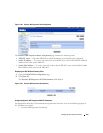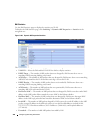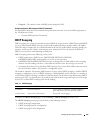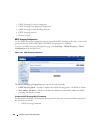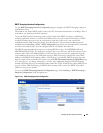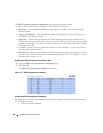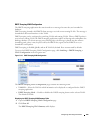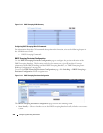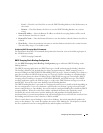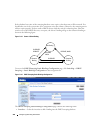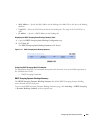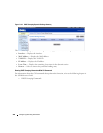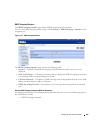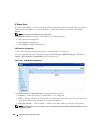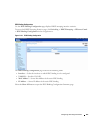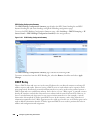
Configuring Switching Information 401
–
Local
— Select the Local check box to store the
DHCP binding database in the flash memory on
the switch
.
–
Remote
— Check the Remote check box to store the
DHCP binding database on a remote
server
.
•
Remote IP Address
— Enter the Remote IP address on which the snooping database will be stored
when the Remote check box is selected.
•
Remote File Name
— Enter the Remote filename to store the database when the Remote check box is
selected.
•
Write Delay
— Enter the maximum write time to write the database into the local or remote location.
The write delay range is 15 to 86400 seconds.
Configuring DHCP Snooping With CLI Commands
For information about the CLI commands that perform this function, refer to the following chapter in
the
CLI Reference Guide
:
• DHCP Snooping Commands
DHCP Snooping Static Bindings Configuration
Use the DHCP Snooping Static Bindings Configuration page to add static DHCP bindings to the
binding database.
The DHCP snooping application uses DHCP messages to build and maintain the binding’s database.
The binding’s database only includes data for clients on untrusted ports. DHCP snooping creates a
tentative binding from DHCP DISCOVER and REQUEST messages. Tentative bindings tie a client to a
port (the port where the DHCP client message was received). Tentative bindings are completed when
DHCP snooping learns the client’s IP address from a DHCP ACK message on a trusted port. DHCP
snooping removes bindings in response to DECLINE, RELEASE, and NACK messages. The DHCP
snooping application ignores the ACK messages as a reply to the DHCP Inform messages received on
trusted ports. You can also enter static bindings into the binding database.
The DHCP binding database is persisted on a configured external server or locally in flash, depending on
the user configuration. A row-wise checksum is placed in the text file that is going to be stored in the
remote configured server. On reloading, the switch reads the configured binding file to build the DHCP
snooping database. When the switch starts and the calculated checksum value equals the stored
checksum, the switch reads entries from the binding file and populates the binding database. A
checksum failure or a connection problem to the external configured server will cause the switch to loose
the bindings and will cause a host’s data loss if DAI is enabled.
When a switch learns of new bindings or when it loses bindings, the switch immediately updates the
entries in the database. The switch also updates the entries in the binding file. The frequency at which
the file is updated is based on a configurable delay, and the updates are batched.



